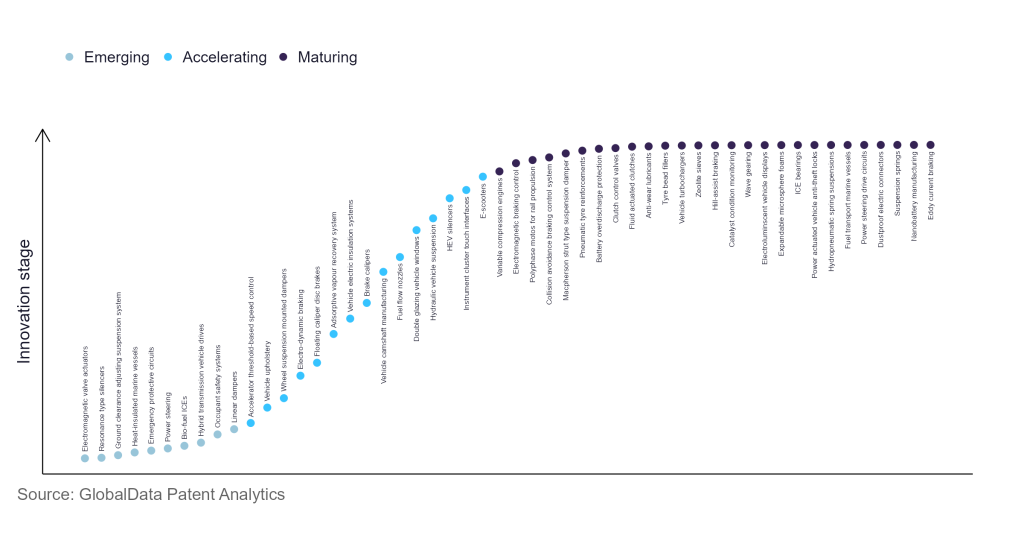The automotive industry continues to be a hotbed of innovation, with activity driven by increasing penetration of electronics into vehicle systems to make mobility safer and enhance in-car experiences, and growing importance of technologies such as artificial intelligence, cybersecurity, Internet of Things, robotics and cloud computing. In the last three years alone, there have been over 1.2 million patents filed and granted in the automotive industry, according to GlobalData’s report on Innovation in Automotive: Hybrid transmission vehicle drives. Buy the report here.
However, not all innovations are equal and nor do they follow a constant upward trend. Instead, their evolution takes the form of an S-shaped curve that reflects their typical lifecycle from early emergence to accelerating adoption, before finally stabilising and reaching maturity.
Identifying where a particular innovation is on this journey, especially those that are in the emerging and accelerating stages, is essential for understanding their current level of adoption and the likely future trajectory and impact they will have.
290+ innovations will shape the automotive industry
According to GlobalData’s Technology Foresights, which plots the S-curve for the automotive industry using innovation intensity models built on over 619,000 patents, there are 290+ innovation areas that will shape the future of the industry.
Within the emerging innovation stage, resilient spoke wheels, auto-transmission lubrication circuits, and ignition switching engines are disruptive technologies that are in the early stages of application and should be tracked closely. Engine purge actuators, electro-dynamic braking, and adsorptive vapour recovery system estimation are some of the accelerating innovation areas, where adoption has been steadily increasing. Among maturing innovation areas are collision avoidance braking control system and direct injection type engines, which are now well established in the industry.
Innovation S-curve for the automotive industry

Hybrid transmission vehicle drives is a key innovation area in automotive
A hybrid transmission vehicle has multiple sources of propulsion. It may get its energy from burning gasoline while alternating between an electric motor and a combustion engine. A portion of the power from the combustion engine is sent directly to the wheels, and the generator simultaneously turns the remaining power into electrical energy. This energy is kept in a battery that can transfer it to the electric motor, which is part of the wheels' power supply, if necessary.
GlobalData’s analysis also uncovers the companies at the forefront of each innovation area and assesses the potential reach and impact of their patenting activity across different applications and geographies. According to GlobalData, there are 20+ companies, spanning technology vendors, established automotive companies, and up-and-coming start-ups engaged in the development and application of hybrid transmission vehicle drives.
Key players in hybrid transmission vehicle drives – a disruptive innovation in the automotive industry
‘Application diversity’ measures the number of different applications identified for each relevant patent and broadly splits companies into either ‘niche’ or ‘diversified’ innovators.
‘Geographic reach’ refers to the number of different countries each relevant patent is registered in and reflects the breadth of geographic application intended, ranging from ‘global’ to ‘local’.
Patent volumes related to hybrid transmission vehicle drives
Source: GlobalData Patent Analytics
Toyota, with 30 patents, is one of the top companies to file patents for hybrid transmission vehicle drives. Toyota Innova Hycross gets a choice of two all-new powertrains. The vehicle can be equipped with a 2l naturally aspirated petrol engine, which produces 172bhp of power and 205Nm of torque, or a petrol-hybrid powertrain based on a 2l Atkinson cycle engine, which produces 184bhp of power and has a fuel efficiency of 21.1km/l. General Motors, Ford, and Honda are a few other notable patent filers in the same industry.
To further understand the key themes and technologies disrupting the automotive industry, access GlobalData’s latest thematic research report on Automotive.
Data Insights
From

The gold standard of business intelligence.
Blending expert knowledge with cutting-edge technology, GlobalData’s unrivalled proprietary data will enable you to decode what’s happening in your market. You can make better informed decisions and gain a future-proof advantage over your competitors.



